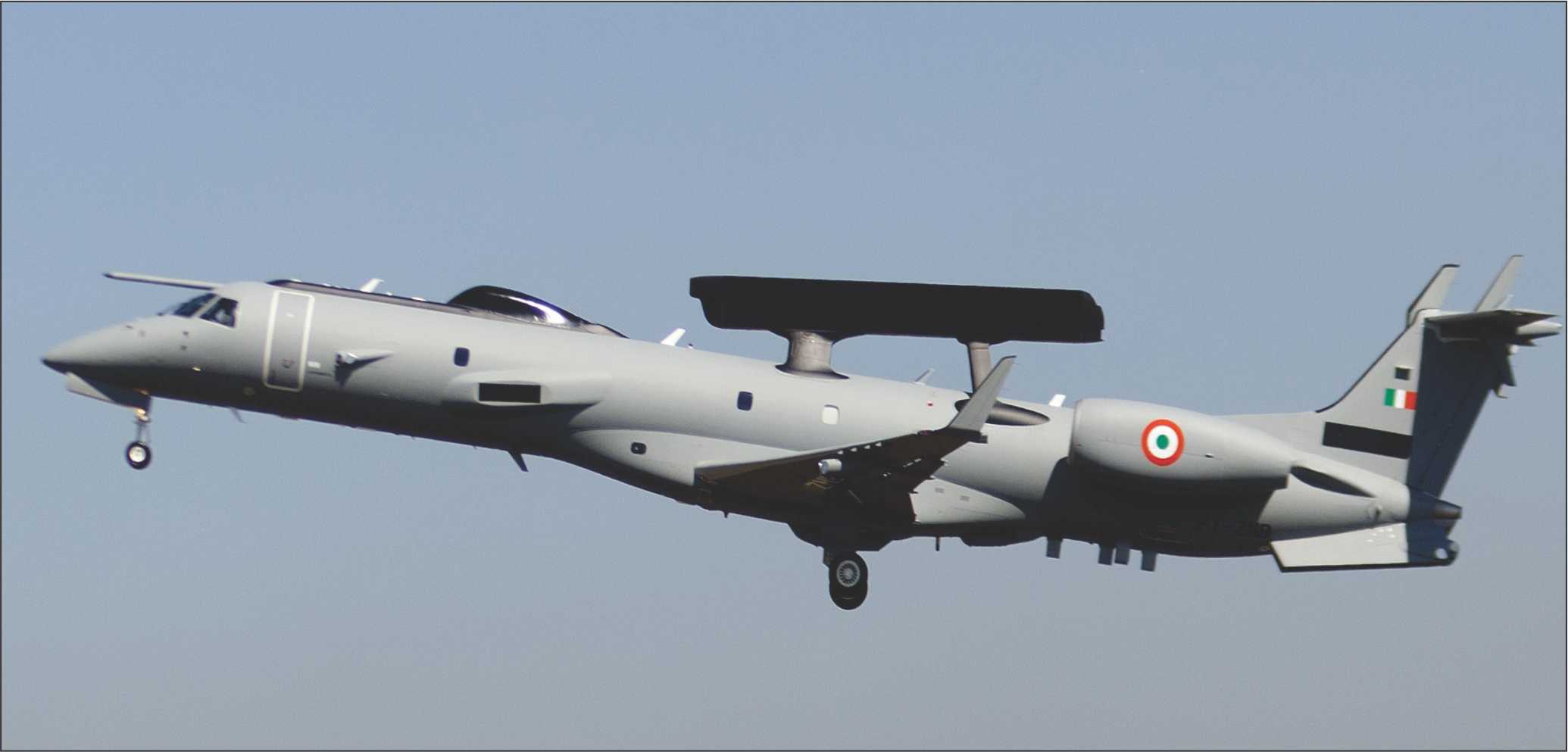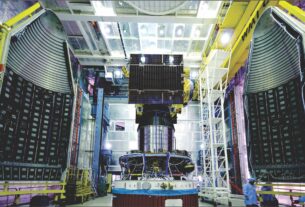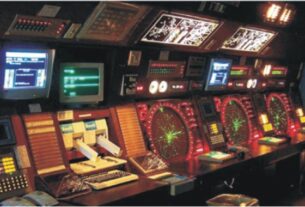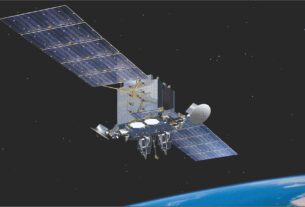Indian defence scientists are inching closely to deliver an operational Air borne early warning and Control System to Indian Air Force and help mount an electronic eye in the sky.
Though the target date was set as April this year, there may be slight delay, but its developer the Defence Research and Development Organisation (DRDO) has shown so much confidence on its surveillance system on a Brazilian aircraft that they dared to showcase this to the international defence visitors during Bahrain defence show in January this year.
Earlier last year in February during the Aero India, the DRDO had flown this aircraft in front of international spectators of top aviation officials and experts. Though Indian Air Force ventured into the surveillance sector with the first acquisition of an Air borne Early Warning Control System (AWACS) in 2009, the order for which were placed in 2004 , the Indian security planners are now moving to an ambitious path to acquire scores of indigenously developed Early Warning Surveillance Systems within next decade.
Indian Air Force is now already operating three AWACS based on a Russian IL-76 platform, on which the Israelis have planted their most advanced Phalcon radars.
The Indian AEW&C based on the Brazilian EMB-145 jets has Indian developed AESA radars and other avionics systems and is lesser in size, range and capabilities, but the EMB-145 will definitely play a stellar role in safeguarding Indian skies very effectively.
Indigenous AWACS
However, realizing the huge operational requirement of the Indian Air Force for such air borne surveillance systems, the Indian Ministry of Defence has given a go ahead to design and develop indigenous AWACS, which will have capabilities similar to the Russian Israeli AWACS.
The MoD is yet to give the clearance for deciding on the air frame to be chosen for the indigenous the Boeing-767 and the Airbus-330 are the options being considered for the next lot of six AWACS, which the Indian DRDO hopes to hand over to Indian Air Force by the end of current decade, if all bureaucratic and political approvals are granted on time.
Commenting on the success of the EMB program, the then DRDO Chief V K Saraswat had said, “The world is watching this program with bated breath. Its success will put our country into the elite group which can develop and deliver such complex state of the art systems. Its development will help Embraer and DRDO to collaborate for producing cost-effective and formidable force multipliers in the global market”.
With the mid January flight display in Bahrain, India has thus claimed the successful culminations of its airborne surveillance systems and hope to enter the world market jointly with the Brazilian firm Embraer Defence and Security with the claim that it will be the cheapest. India had acquired the three Jets from Brazil for a contract of US$ 210 million and after adding the comprehensive costs of final integration of all the radars and avionics it will be much cheaper, claims DRDO officials.
The S-band radar system was claimed to have been developed indigenously for which the technology was denied by the developed world to India. The AESA transmit-radar modules were also developed locally and integrated into the Embraer jet by Indian experts.
Other than CABS, various other DRDO establishments have provided key components including the self protection suite, the data link and the communication systems for the surveillance systems. CABS thus claims to have acquired mastery over the airborne surveillance systems.
According to the CABS for the first time the aircraft will have an air to air refueling capability for extending its range and endurance during a combat situation which will help in uninterrupted surveillance on the enemy flying activity. The Cabin of the AEW&C has five operator work stations, four equipment racks, additional fuselage fuel tanks and five rest crew seats.
India did try to develop an indigenous airborne early warning system in the 90s on an Avro- HS -748 aircraft, but the effort came crashing down in 1999 with eight scientists on board. The CABS was set up in 1991 to run the Airborne Surveillance Platform called AIRAWAT. However the AIRAWAT project was revived in 2005 and the Brazilian EMB-145 was chosen for the flying platform.
According to the program Director (AEW & C) and Director CABS , Bangalore , Dr S Christopher , the IAF projected a requirement for an indigenous AEW&C system based on a smaller regional jet platform to act as a mini AWACS in order to achieve operationally more agile solutions. A joint DRDO-IAF team finalized the specifications for such an AEW&C system to be built on the Brazilian EMB-145 aircraft.
Development
DRDO, which is spearheading the Indian AEW&C program, the Center For Airborne Systems ( CABS) as a nodal agency in close association with other DRDO sister laboratories, Electronics Research and Development Establishment (LRDE), Bangalore, Defence Avionics and Research Establishment (DARE), Bangalore, Defence Electronics Research Laboratory (DRDL), Hyderabad and Defence Electronics Applicatiosn Laboratory (DEAL) Dehradun, pursued the development of the AEW&C airborne surveillance system.
The CABS undertook development tasks on various subsystems like the primary radar, secondary surveillance radar, electronic countermeasures, communication countermeasures and data links, identification friend or foe, mission communications systems, self protection system, data handling and display systems and Mission System Controller (MSC) indigenously. The primary sensor for the AEW&C is the Active Electronically Steered Array (AESA) radar both with a normal detection range and an extended range against a target radar cross section (RCS) of the fighter type aircraft. Thus the Indian AEW&C equipped with AESA radar will help track multiple targets and send alert warnings to the defensive aircraft and the surface to air missiles.
After the Kargil conflict, India decided to acquire such system on a priority basis by importing it and signed a tripartite agreement in 2004 with Russia and Israel for three AWACS worth US$ 1.2 billion. Before making these AWACS operational from the year 2009, India decided to develop jointly an indigenous AEW&C with Brazil, which presented a cost effective model and confidence to work on next generation full sized Indian AWACS on a much bigger platform like the Boeing 767 or the Airbus-330.
Presently, the DRDO has decided to hand over two of the three AEW&C aircraft to IAF for operational use and has retained the third aircraft as a test and development platform for next class of indigenous systems under development.
The next AWACS from India will also have a rotating radar dome and also be electronically steered radar like the AESA, which will provide 360 degrees coverage. Due to enhanced space requirements for its radars and systems, DRDO has decided to go in for a bigger air platform. Though the DRDO has told the Ministry of Defence that they would like to hand over the Indian AWACS to IAF by 2020 but many of the work and design parameters have not yet been set and even the airframe has not yet been selected. It remains doubtful, whether in the event of an impending budget cut; the MoD will be able to provide the necessary funding for the Indian AWACS to continue working on the system with full speed.
Considering the very long and active borders with China and Pakistan and huge deployments of surface to surface missiles with nuclear capabilities across the borders targeting India, these Eyes in the Skies are of extreme relevance in the current scenario.
Hence India needs to deploy these electronic eyes on a priority basis. In fact Indian armed forces would feel handicapped in the absence of sufficient number of air based surveillance platforms, as these would provide sufficient reaction time, which at times are in seconds and not minutes.
Though India was the first country to induct the AWACS in South Asia, Pakistan followed soon with the Swedish SAAB Eric Eye Airborne Early Warning and Control aircraft in its fleet. India’s first AWACS arrived in May 2009 and Pakistan announced its arrival in December 2009.
Clearly the race to control, command, guide and manage the war from the sky is getting more intense and the effort is to deploy such warning systems on all the fronts. Deploying four Eric Eye by the Pakistani AF on Indian borders would meet the combat requirements of the Pakistani armed forces but India needs to have these eyes in the sky in large numbers to keep an eye on the Chinese and the Pakistani activities.





